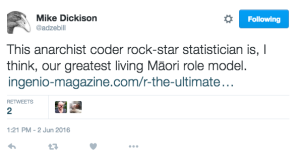I didn’t see this Stuff story at the time, but it was discussed on Twitter by Tess McClure (@tessairini).
The 2016 Global Slavery Index examines practices such as forced labour, human trafficking, child exploitation and forced marriage, surveying 43,000 people in 25 countries.
The number of people living in slavery in New Zealand has increased from 600 in the 2014 Global Slavery Index.
New Zealand and Australia have the lowest level of slavery prevalence in the Asia Pacific region with an estimated 0.018 per cent of the population in modern slavery.
If you survey 43,000 people in 25 countries you won’t be surveying very many in New Zealand, so where did this number come from? The story doesn’t give any more details, but @tessairini found a ‘detailed methodology’ paper (PDF).
They didn’t survey any people in New Zealand. Or in Australia. Nor had they in 2014.
The survey part of the research is pretty much irrelevant to the estimates for New Zealand. The methodology paper describes another approach that
…can be applied in countries where nationally representative random sample surveys will not necessarily work. This is particularly the case in more ‘developed’ countries, where low levels of vulnerability mean that there are few cases to report, where law enforcement is strong and organized crime is more hidden, and where the resulting numbers are so small, that even if they were not hidden, they would be highly unlikely to be found and selected for interview in a random sample survey.
For the UK and the Netherlands the survey used data from the overlap of multiple lists. The UK estimate is described in Significance magazine, the popular-audience publication of the Royal Statistical Society. In all, 2744 victims of human trafficking were identified in the UK, from a total of six sources, so it’s possible to look at how many of these people were missed by each source, and estimate how many more might have been missed completely. The estimated total is between 10,000 and 13,000.
So, there’s survey data for 25 countries not including New Zealand or Australia, and multiple-list data for two further countries not including Australia and New Zealand. We still haven’t found out where the New Zealand estimate comes from.
The final step is extrapolation from measured countries to unmeasured countries. The researchers measured a whole lot of variables that might be relevant, and divided the countries into groups that looked similar. They then applied the frequencies from the measured countries in each group, with a few adjustments, to the unmeasured countries. If you look at the data in the Stuff story, Australia and New Zealand have the same estimated prevalence of slavery, 0.018% of the population. That’s also essentially the same as the UK estimate, so presumably we’re in the same group as the UK and that’s where the real data come from.
If you want a global estimate of the number of people affected by slavery, this is a perfectly reasonable approach. It’s probably kind of ok as an estimate for the number in New Zealand. On the other hand, the index data doesn’t support claims of change from year to year in New Zealand, and it doesn’t say anything about particular risks.
It makes sense to get local experts to talk about the industries and practices that might cause problems in New Zealand, as Stuff did, and what can be done about them, but the index estimate is just that New Zealand is about the same as the UK.
 How did the statistical programming language R grow from a simple help-out for undergrad students to a global sensation? Associate Professor Ross Ihaka (right) of the University of Auckland
How did the statistical programming language R grow from a simple help-out for undergrad students to a global sensation? Associate Professor Ross Ihaka (right) of the University of Auckland 
Recent comments